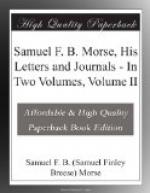“I exhibited the Telegraph to the Institute and the sensation produced was as striking as at Washington. It was evident that hitherto the assembled science of Europe had considered the plan of an Electric Telegraph as ingenious but visionary, and, like aeronautic navigation, practicable in little more than theory and destined to be useless.
“I cannot describe to you the scene at the Institute when your box with the registering-machine, just as it left Speedwell, was placed upon the table and surrounded by the most distinguished men of all Europe, celebrated in the various arts and sciences—Arago, Baron Humboldt, Gay-Lussac, and a host of others whose names are stars that shine in both hemispheres. Arago described it to them, and I showed its action. A buzz of admiration and approbation filled the whole hall and the exclamations ‘Extraordinaire!’ ‘Tres bien!’ ‘Tres admirable!’ I heard on all sides. The sentiment was universal.”
Another American at that time in Paris, the Honorable H.L. Ellsworth, also wrote home about the impression which was produced by the exhibition of this new wonder:—
“I am sure you will be glad to learn that our American friend, Professor Morse, is producing a very great sensation among the learned men of this kingdom by his ingenious and wonderful Magnetic Telegraph. He submitted it to the examination of the Academy of Sciences of the Royal Institute of France, at their sitting on Monday last, and the deepest interest was excited among the members of that learned body on the subject. Its novelty, beauty, simplicity, and power were highly commended....
“Other projects for the establishment of a magnetic telegraph have been broached here, especially from Professor Wheatstone, of London, and Professor Steinheil, of Munich. It is said, however, to be very manifest that our Yankee Professor is ahead of them all in the essential requisitions of such an invention, and that he is in the way to bear off the palm. In simplicity of design, cheapness of construction and efficiency, Professor Morse’s Telegraph transcends all yet made known. In each of these qualities it is admitted, by those who have inspected it closely, there seems to be little else to desire. It is certain, moreover, that in priority of discovery he antedates all others.”
Encouraged by the universal praise which was showered upon him, the hopeful inventor redoubled his efforts to secure in some way, either through the Government or through private parties, the means to make a practical test of his invention.
Mr. F.O.J. Smith had, in the mean time, returned to America, and Morse kept him informed by letter of the progress of affairs in Paris. Avoiding, as far as possible, repetitions and irrelevant details, I shall let extracts from these letters tell the story:—




